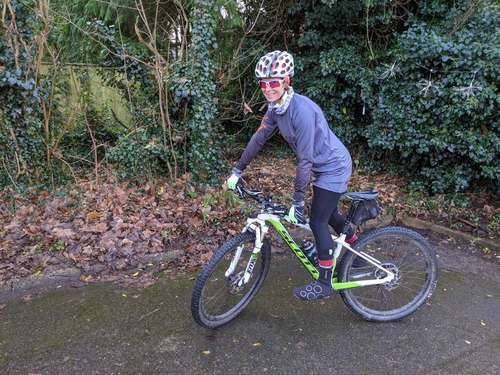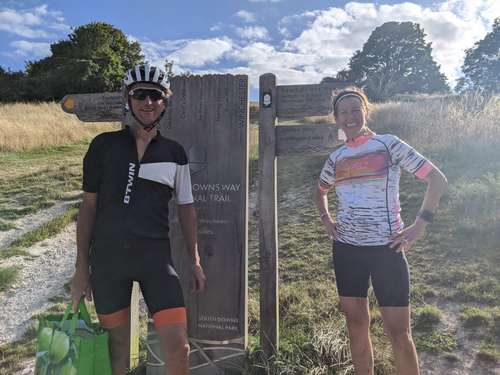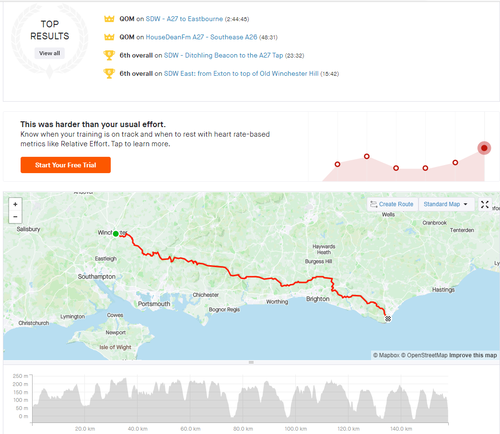A Triathlon-ish Blog
Learn how to track stand

I've wanted to learn to track stand for a while - it can be a useful skill out on the trails (especially on tight uphill switchbacks) but, most importantly, it looks Cool!
I got into biking very late in life, so I never did that hanging out on bikes and learning tricks. In the past I've made some half-hearted attempts to learn to track stand - mainly asking better riders than me how to do them. They'd then do a lovely demo and I'd try the same and my front wheel would suddenly self-identify as a crazy windscreen wiper, thereby ending any further attempts to learn.
Being a geek I then turned to the internet for guidance. There are some YouTube videos but, frustratingly, most focus on how to do a track stand as opposed to how to learn to do a track stand. Somehow I fumbled through and now I can do them. So, I decided to put together this little blog-torial to share how I learnt. I'm under no illusions that I'm an expert but hopefully there's some useful info here to help you learn.
Before you start, I'd recommend you check out two resources I found useful:
- Asa Sala's article: www.primalwear.com/blogs/team-estrogen/how-to-track-stand
- Anna Glowinski's video: www.youtube.com/watch?v=6VyDY-OPhIA
Anna's key coaching points are:
- Learn up an up-slope (also I found grass to be much easier)
- Be out of the saddle
- Pedals level, with your favourite "chocolate" foot forward
- Turn the front wheel towards the chocolate foot
- Eyes looking 1-2 m ahead
- It's easier on flat pedals (I learnt clipped in as I didn't have flats and had some stressy "I can't clip out" moments. But, hey, if you're not living on the edge, you're taking up too much space!)
- Find somewhere private to practise!
I'd add thinking about engaging your core, trying to stay loose and staying off the brakes - if you're on an upslope then you shouldn't need your brakes. Instead, try and find the balance between applying forward pedal pressure on your chocolate foot and then feeling gravity pushing your foot back. It's a subtle rolling back and forth motion.
How to learn
So, the first thing is to become comfortable at ratcheting (standing up and moving your pedals smoothly between 1 o'clock and 5 o'clock). This is easier on a slight upslope.
Once you can do this, then ratchet, standing up and riding in circles (both directions) and figures of 8. Have a fun play around doing this.
Then, progress to riding (still ratcheting) switchback up a slope in a continuous S pattern - like an uphill slalom. The aim here is to purposely come to a momentary pause (normally just as you are turning the corner and the front wheel is pointing up the hill) and then continue ratcheting and keep repeating (shown in the video below.) I found doing left-hand turns way easier (my chocolate foot is my left one) than right-hand turns.
Key is to spend a lot of time riding across a slope and turning up the slope in your favourite turning direction while ratcheting and trying to pause. Gradually the momentary pauses became longer and longer and then, I was like, Yey, check me out! I could find the sweet spot almost instantly.
I hope that's been useful and that you have fun playing on your bike.
The South Downs Way in a day - 100 hilly miles on a mountain bike

A couple of weeks ago on a ride with my friend, Pete, riding the South Downs Way (SDW) was mentioned. And by nightfall I'd agreed to attempt it in a day. Almost instantly I regretted the decision, as my brain flooded with worries, worries and more worries.
The South Downs Way is not to be under-estimated. Whilst only 100 miles, it is predominantly off-road with over 3,500 m of climbing (as a gauge the Ben Nevis summit is 1,345 m). A lot of the terrain is extremely exposed and it's rare for it not to be tremendously windy. Completing it within 10 hours is considered an achievement. And I'd just agreed to ride it with someone much, much faster, fitter and more skillful than me. I train for 1-hour flat out cross-country races...what the frig was I doing!!??
The logistics are an additional challenge. We needed to get ourselves to the start, have sufficient food and drink available and then get home. Our plan was for Pete to drive us to the start, picking me up at 04:30 and my husband kindly agreed to meet us twice on route (at Bignor Hill and Ditchling Beacon so we could grab provisions) and then again at the end to drive us home. Pete then had the job of collecting his van the following day.
So, on Tuesday 28 August just after 6am, Pete and I set off from Winchester and a little over 10 hours of riding later we arrived in Eastbourne like Cheshire Cats. I'd done it! And, I'd loved all of it. The scenery had been stunning, the weather was kind-hearted and the Goddess of Mechanicals had looked down on us favourably.
Here's a few things I did that really helped me:
- Respect for the SDW! 10 days before, I did a 4-hour ride on the South Downs. It was meant to boost my confidence. But I rode it under-fuelled, too fast and the heat was unbearable with sweat dripping into my eyes. Afterwards I had a spaced out feeling and my confidence was anything but boosted. In hindsight this was a blessing in disguise. It meant that I needed a plan! I agreed with my coach, Jenny Copnall, to ride to heart rate and stick to 130-150bpm (my zones 3 & 4). For some of the hills it was impossible to keep this low but overall I stuck to this pacing as much as possible.
- A working and comfortable bike. At the beginning of the year I had a bike fit at Cyclefit and I'd thoroughly recommend them. Also, just before, I got my bike serviced at Velocipede Cycles, who I race for. So, I was as confident as I could be that the bike wouldn't be the limiting factor!
- Nutrition. I was super worried about this as I usually have no appetite when riding. But I put together hourly bags on 50-60 grams of carbohydrate and I force fed myself the contents. I used a mixture of bananas, fig rolls, garibaldis, roast potatoes, bagels, jelly babies and fingers of fudge. For drink I had water and electrolyte tablets.
- An "enjoy the moment" mindset. I deliberately didn't have distance showing on my Garmin as I didn't want to be obsessing about that. I just had time (and heart rate). I intentionally didn't know how many big hills there were or when they were. My approach was that I would just have to ride whatever was ahead of my front wheel.
- Comfort. Any ride over 3 hours and my saddle becomes quite uncomfortable. This became quite a stressor for me, so I decided to switch my normally super comfy road saddle onto my mountain bike but somehow this was even worse so I switched back to my original saddle. I couldn't see how my bootie was going to last the 10-hour ordeal! At the very last minute I decided to wear two pairs of shorts. This totally went against my usual "nothing new on race day" approach but the risk luckily worked out and my bootie survived!
- Good company. I loved riding the SDW with Pete. Not because he kindly opened 99% of the countless gates (my attempts normally accidentally inflicted pain on him); but because it feels like we share the same magic and joy of cycling.
The experience has been a brilliant reminder for me to try to not fear failure and to pick up the dice and roll'em because outside the comfort zone is where the magic can happen!
The Cheshire Cats in Eastbourne

If it's not on Strava, it didn't happen!

I have no words
An editorial on Covid-19 for The Sport and Exercise Scientist, Summer 2020, Issue 64
The date is 3 April 2020. Today, worldwide coronavirus cases reached 1 million. In a short space of time, the world has changed immensely. Like many, I haven't had time to stop and take stock. I am throwing myself into juggling work, parenting and teaching. I'm also trying to process that my dad is now receiving palliative care in an isolation ward, having caught Covid-19. The call I don't want is likely to come today or tomorrow.
It's hard. It's extremely hard. Most of the time I have no words.
Only a few weeks ago, adults were still at work, children were still at school, pubs and restaurants were busy, sport was being played, I could easily get a next day supermarket delivery slot and people weren't embarrassed at the state of their hair. Toilet roll, hand sanitiser and paracetamol were aplenty. People shook hands, hugged and kissed those they knew. With strangers, maybe a nod, a hello, eye contact, even a smile. People could exercise as much as they wanted without neighbours ringing the police.
With barely noticeable steps, headlines about what was happening in China, Italy and other countries became applicable to the UK. Each day the number of confirmed cases crept up; most tagged with: s/he had an underlying health condition. I will pause briefly on those last five words.
My feel is that someone high up the food-chain believed that "an underlying health condition" was a key message. It seemed a consistent message; almost a tag line. Perhaps the intention was to try and allay widespread fear and panic? My honest initial reaction when hearing or reading those words were twofold. The first (wrongfully), is that, that person's death isn't as much as a tragedy as someone's without underlying health conditions. The second is that, Covid-19 isn't relevant to me. I think if the powers that be had focused on a different key message, perhaps we wouldn't have seen such blasé behaviour as on Mothering Sunday weekend. Parks and National Parks were packed - "social distancing" was not being adhered to. There's a learning curve here for all of us: words matter; every sentence matters; and key messages really matter. This is perhaps something to reflect upon.
The other issue I wish to briefly pause on is "bottom lines." When Covid-19 is all done, there will be a total death toll number. What that number will hide is each important individual. It doesn't do justice to the horror of Covid-19 and what "isolation" means to families affected. My family want to be with my dad. We will want to be with my mum but won't be able to. It's heartbreaking. So, let's not be in a rush to get to the bottom line of our work and research and miss important aspects. Rich description is important.
Our community has a lot to offer with regards to dealing with the undeniable impact of the Covid-19 pandemic on emotional well-being and mental health. Many people don't cope well with enforced change. Many now have considerable financial worries. Most people's daily routines are in chaos; interactions are minimal. Social distancing and self-isolation are hard. Not all people are in happy homes.
All competitive sport has been cancelled for the foreseeable future. Athletes, coaches and support personnel are having to reframe. For a while the summer show-piece held out, adamant that the Olympic and Paralympic Games Tokyo 2020 would run. Lockdown in some countries made it impossible for athletes to train. The uncertainties proving increasingly difficult. With mounting pressures to postpone, the Games organisers announced it will now be held in 2021. Many people will now be busy adapting plans.
Personally, I've found a few things useful in adapting to the new "normal." A tip from Anna Glowinski (a bike rider isolating in Spain) was to "make life about something else" - she's allowing herself only 5 minutes a day of catching up on coronavirus news. I implemented this straight away and found it helpful.
In addition, my friend and psychologist, Dr Mark Bellamy has done a couple of nice Facebook posts. In the first, he talked about the 4 x 3 format that puts some structure into the day:
- 3 x 20 minutes exercise or physical activity
- 3 x 20 minutes social phone calls
- 3 x activities that bring you joy
- 3 x meals that truly nourish you.
I like this and it's working for my family. Our daily outdoor exercise is an essential part of our day. Like many, I will really struggle if this is taken away.
Mark's second post was a rework of Maslow's hierarchy of needs. It was re-worked so that the base level basic need is "Support the NHS." The NHS's message is clear: Act like you have got it. Anyone can spread it. Stay home. Protect the NHS. Save lives.
The world has changed immensely in the last few months. This pandemic is affecting everybody, everywhere. We need to remember that not all are affected equally. When things go wrong, inequalities are magnified. I sincerely hope we can emerge from it all with some aspects of life enhanced: being better global citizens; being more community-spirited; and ensuring a better work-life balance.
Dr Claire Hitchings FBASES - Claire is Editor of The Sport and Exercise Scientist. She is a triathlon coach and runs Claire Hitchings Coaching (www.clairehitchings.rocks). She currently lives in a messy house, juggling parenting, home-schooling, working and training.
This editorial will be published in The Sport and Exercise Scientist, Summer 2020, Issue 64. Published by the British Association of Sport and Exercise Sciences - www.bases.org.uk
RIP Dad - you had an innings to be proud of! I will miss you. xox
